#I wanted to add more screenshots
Text
A Who-Swung-It Mystery: The Case of the Switch-Hitter (2/3)
1 / 2 / 3
Another fun fact before the cut, did you know that the term sinister, meaning evil or lurking danger, comes from the Latin term sinister, meaning of the left side? Its antonym, dexter, means on the right side.
Just the warning one more time: despite the humorous title, I want to be serious for a second. I am not a licensed psychologist/psychiatrist/licensed social worker/etc., and I am certainly not an expert on dissociative identity disorder (DID). My knowledge of this disorder comes from the research I have done to try and understand it. I am trying to be as respectful as possible towards the subject matter, and I sincerely apologize if I show a lack of understanding and will do my best to correct it. Any mention of DID is more focused on switching since we haven't got a clue as to how Mikoto developed DID, and the how isn't really important to the murder itself.
Again, I apologize for the length. Building a case against Mikoto has been a proper pain in my ass because of the constant misdirection from John. If you missed it, I argued that based on the behavior shown by Mikoto and John, I believe that Mikoto is the killer and John is attempting to shield him by taking full responsibility. John's acts of erasing what Mikoto has done led him to believe that his murder of the blond, young man seen in MeMe was just a bad dream. I also drew a connection between Mikoto and John and Dr. Jekyll and Mr. Hyde. I just find it fascinating that John is depicted as the Hyde to Mikoto's Jekyll, but instead of wreaking destruction, John provides Mikoto with protection by playing into the evil alter trope and claiming he had been the one to kill. I also talked about switch-hitting and why batting left, despite being naturally right-handed, is something Mikoto would do, not John.
If you'd like to start violently shaking me again, feel free!
One or Two: How Many Alters are There?
Ultimately, my theory hinges on the belief that it is just Mikoto and John. Initially, I believed that there was only Mikoto and another personality (the dual personalities, collectively called Bokuto and Orekoto until Neoplasm). Then, after seeing some really good Trikoto arguments (Aokoto, Akakoto, Midorikoto) that justified it with the existence of a third personality, I started believing it too. Now, I'm hearing that Yamanaka debunked the Trikoto theories when Double was first released, I'm back to thinking that there are just two personalities: Mikoto and John. Although, I would not be upset if Trikoto was right. Those were some really thorough arguments using lighting, and I ended up looking back at the use of lighting when I was analyzing MeMe.
A huge part of the Trikoto arguments were the use of blue, red, and green lighting throughout MeMe. That is when I noticed something about the red light. While red light overwhelms the mental mindscape whenever John appears, the use of red light in the physical world is rather minimal and only used twice. Both times that it is used the physical world, it involves the victim's point of view (the left-handed swing and the implied burial), and the red light is a small amount reflected off of Mikoto's eyes.
MeMe's Use of the Mental and Physical World
In MeMe, we can very clearly see the difference between the physical world and Mikoto's mindscape. There are no moving parts to it, and it is isolated to one location. His mindscape is combines the layout of his studio apartment (we can see his couch, coffee table, and TV stand) with the crumbling tile walls that seem to come from his bathroom. The physical world in MeMe depicts various locations, starting with the scene of the crime and ending inside of Mikoto's apartment. We are also shown two scenes where John gets rid of evidence by burying the body (implied by the dirt being tossed over the camera) and throwing out the bloodied clothing in the dumpster (explicitly shown).
The physical world scenes use green-blue tints, and I found that the use of more green lighting than blue or vice versa is subjective to a viewer's definition of which color is more dominant and it is inconsistent, making it difficult to tell who is fronting. Personally, I think it is used to help misdirect the audience because the color of the lighting and the behavior of Mikoto and John are inconsistent.
The mindscape does not have this problem. Not only does it have a stark division between Mikoto and John by using the peaceful blue water to represent Mikoto and the stained water/red blood to represent John, but it also has blue mindscape Mikoto and red mindscape John behave how we expect them to (Mikoto is confused and pleading while John is mocking and menacing). It's pretty clear that the image Yamanaka wanted when we think of John is red = aggression. Perhaps the overkill of red light in the mindscape is to make it clear that John is now fronting and in control, while the minimal use of in the physical world is to highlight how hidden DID can be or how switching can be ignored or written off. In addition to the lighting, I would like you to also take a look at the use of eyes, tarot cards, and right-left dichotomy in MeMe.
At the very beginning of MeMe, there is a red haze over the mindscape and we see who we can presume to be John pick up the camera and smile at the audience. Then it cuts to the two large tarot cards of the Hanged Man (reversed) overlapping the Fool (upright) in the blue mindscape. The reversed Hanged Man is on the right while the upright Fool is on the left. From what I can tell, a reversed Hanged Man seems to mean that a person feels as though they are sacrificing a lot without getting much in return or it is not turning out the way one would expect it should. Knowing what we know about Mikoto's workplace, this might be referring his boss overworking him with unrealistic expectations. It overlaps the upright Fool card, which usually represents new beginnings. This could refer to John's 'birth' but I think it probably represents Mikoto being hired at his company. The stress from the overwhelming work load now overshadows this amazing new opportunity.

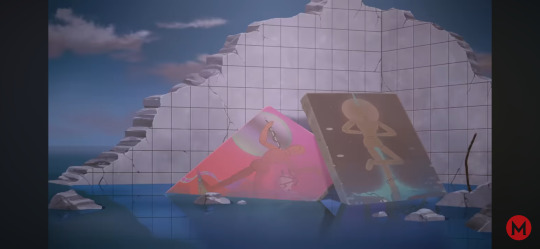
We cut to the train tracks to witness the part of the meeting and murder of the blond man. If you look at the area, it’s secluded and dark. It’s not a place where you just take a stroll. Mikoto is waiting for someone. There is no bat, and it looks like Mikoto is loosely holding his phone in his hand. We cannot make out his expression, much less see his eyes. Then we jump forward to the victim’s point of view to see Mikoto ready himself for a left-handed swing. His arms make it hard to see his expression, but we can make out his left eye, which is reflecting red light. During the right-handed overhead swing, implied to be the kill swing, we cannot see Mikoto’s eyes. And, I didn't realize this when I first watched MeMe and Double, but MeMe actually does pose the idea that Mikoto seems to believe that he dreamed of killing a person, something Double insists on. The lyrics during the murder shown in MeMe ask, “How long would this dream go on?”


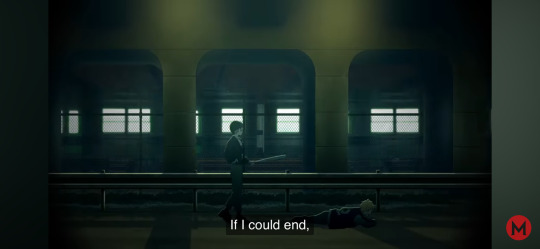


When Mikoto returns to his apartment, Yamanaka avoids showing us his eyes at first. After taking off his shirt, it looks as though Mikoto is looking back at the audience, but his hair is blocking most of his right eye. We then cut to him on the couch for the "Switch / Shake up that brain" line where we can see his left eye but his bangs hide his right eye completely. Then, we are first transported to the blue, clean water mindscape where his right eye is the one that opens. I think this is the early evidence that we are meant to associate Mikoto with his right side and John with his left, because there is so much left and right action going on in both songs that I'm getting a headache. Back to the couch, Mikoto reaches for a tarot card, and the mindscape world turns dark and has a laid out array of tarot cards overlaid his stacked deck where Mikoto first picks the Devil (upright) tarot card. The upright Devil tarot card usually signifies depression, addiction, or despondency. This could be the stress from being overwhelmed with work. It is supported by the glitchy cut following this, where we see Mikoto come into his apartment late at night and break down into tears.
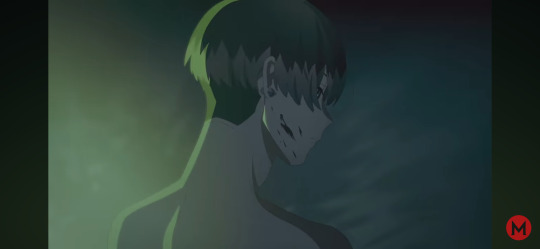

Again, we cannot see Mikoto's eyes when he disposes of the trash bag and his bloody beanie or when he brushes his teeth (right side of his mouth, actually) while his left cheek is splattered with blood. We have more focus on the left-right split where Mikoto has his left hand beside the bathroom mirror as John looks on in concern. And then we see Mikoto's right (and visibly covered by his sweater sleeve) hand rest beside the mirror as John gives the creepy, menacing smile. Mikoto reels backwards and the Devil tarot card falls into his lap. Coincidentally, John doesn’t appear in the mindscape again until the Devil tarot card falls a second time and hits the water of the mindscape, turning it blood red. It almost seems accidental, with Mikoto watching the tarot card fall to the ground in horror. John stands behind him menacingly, but his eyes are hidden. We don’t yet know his intentions, but with the menacing red light, we are led to believe that they are bad. The Devil tarot card being repeated three times could signal Trikoto, but I think this may just be to establish John's existence before Mikoto got his current job. He has been there, watching Mikoto with concern (first mirror appearance), and then John was proud of being able to intervene with something that had happened, possibly creating the blackmail material (hence the proud smile in his second mirror appearance). Neither mirror appearance is directly preceded by a Devil tarot card. The second mirror appearance actually comes before the tarot card. I could see the mirror appearances predating the Devil tarot card as a sign that John attempts at helping Mikoto relieve his stress only made things worse, leading directly to the murder.
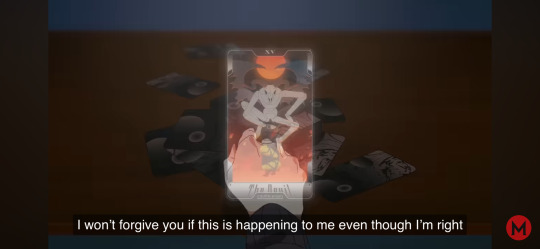



After we see John in the mirror a second time, Mikoto seems to stumble backwards before he falls while the lines, "Why am I here? / It must be a mistake? / Take a good look at me / Until you find me" plays. I would argue that this is when Mikoto meets with his victim. They're two adults meant to talk things out. This is just a mistake that can be cleared up. This is when we see the Devil tarot card-for the second time overall-fall into his lap. The victim lays out his blackmail threat. Mikoto is despondent, and when he picks up the card, the image burns away. The lyrics played are, "The truth will come to reveal itself / I will NEVER forgive you if this is happening to me even though I'm right" and I think this is when the seriousness of the situation hits. The mindscape is still blue as Mikoto sings, "All those ridiculous accusations" and then when the Devil tarot card falls to the ground, the mindscape glitches from blue to red to blue to red for "Hurting it / Holding it down". Now, this could be a sign of Mikoto starting the murder (at minimum, he delivers the first, left-handed swing of the bat) and John ends it by disposing of the evidence. Who delivered the second, deadly swing can be debated. I lean towards Mikoto delivering the deadly blow, and I will get to it in a minute.
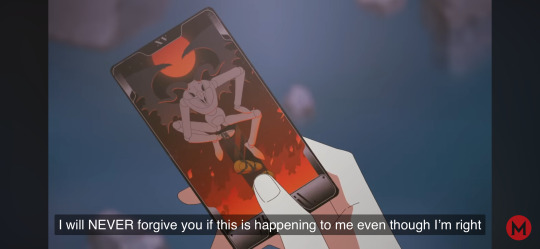


This third appearance of the Devil tarot card directly precedes John's appearance in the mindscape, implying that John took over during some immensely triggering event. Based on how Mikoto seems to be frozen with horror during this time, I think this was when Mikoto realized that he had killed someone (hence the "My life... it wasn't supposed to be this way," glitched line from the first voice trailer. He cannot comprehend what he had just done, and John took over to dispose of the evidence, so Mikoto can just disregard this as a dream. Because Mikoto and John are both present for, "It doesn't change anything, does it / It's the same anywhere I go / It's like what's wrong isn't wrong / I'm already the fake one" it is hard to tell who is singing, but the self-pitying language makes me think of Mikoto, not John. Mikoto just wants to go along and get along but everyone around him insists on making trouble. First the victim threatening to get him fired, then Es insisting that his little dream was reality, and then Kotoko attacking him.




I think that when the mindscape turns red a second time, it is supposed to represent the switch during John Doe. Mikoto is pleading for Es to answer him and truly see his reality, “Why am I here? / It must be a mistake, right? / Take a good look at me / Until you find me,” and then he snaps, briefly turning the mindscape red on an overhead view. It’s almost as if the switching is done on purpose. From what I've read, forcing alters to switch can happen, but it is not advised because of the potential repercussions within the system. More than likely, Mikoto snapping before switching with John symbolizes Mikoto facing another trigger, this time the reality that his dream of killing someone wasn't a dream, and then John taking over to protect that belief. But it’s John’s behavior and the lyrics that we see while the mindscape turns red again that I want to focus on: “Hey why, / I’m nowhere to be found / So / I will NEVER forgive you if this is happening to me even though I’m right”

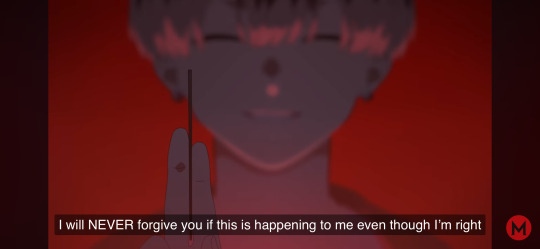

John is taking Mikoto's words and actions as his own. He takes the passive aggressive remark of Mikoto's refusal to forgive and makes it a clear threat and draws the tarot card. He doesn't do it the same way, though, because this time he clearly shows off the tarot card rather than letting us look over his shoulder. John has his eyes closed, upturned to match his smile, and then they open as his expression turns cold. While his eyes are closed, we see the back of the tarot card, and when they open, he turns the card so we can see it. It’s the Fool tarot card, which again, generally signifies new beginnings. We flash to more tarot cards lying on the table before John pulls out the Death (upright) tarot card and then John moves to punch the camera. As many people have already stated, the Death tarot card doesn't mean actual death, and usually signifies a major change has already come, is currently happening, or will come soon. With the Fool and Death tarot cards combined, John is making it clear that his role as Mikoto' protector is now going to become proactive as he plays up the idea that he is the uncontrollable, evil Hyde to Mikoto's even-keeled and good Jekyll.
I'll admit that this theory of mine has its weaknesses. Primarily, it's the stupid blood splatter on Mikoto's face while he is in the physical world. When he strips off his bloodied clothing, there is a blood splatter on his right cheek, but when he buries the victim, the blood splatter is now on his left cheek, not his right. In the shower while he brushes his teeth, the blood splatter is on his left cheek. That pokes a hole in my only one victim theory. There is a chance that since the blood stain on his right cheek is very close to where his jawline and ear meet that the clod of dirt and the angle we see Mikoto at hide it during the burial scene. Just like how there's a chance that John took more care to make sure Mikoto's right side was clean since Mikoto is associated with the right side and John with the left. It is a weak defense. I can admit to that. But I hope I've provided enough evidence to help support my argument. Maybe that right cheek bloodstain is related to the blackmail material.



Why I think that it's John disposing of the evidence... it's like how I said it in the last post; while John is trying to be more proactive by taking the blame for everything to protect Mikoto, John is more reactive and less careful than Mikoto. In John Doe, John literally beats the shit out of Es, someone who holds the fate of Mikoto in the palm of their hand. Most people would not antagonize and threaten someone with that kind of power. John is short-sighted, and until he's restrained and forced to think and plan during Neoplasm, John's pretty terrible at actually helping Mikoto. Yes, we see him bury what we can presume to be the victim, but we don't know what happened to the murder weapon (the baseball bat that should be covered in blood and dents) and the bloody beanie was not stuffed inside the garbage bag before being tossed into the dumpster. The dumpster isn't very tall. Anyone could look in and see the blood-stained beanie. Despite showering to get rid of the blood on him, Mikoto clearly strolls into his apartment covered in blood splatters. Anyone could have seen him. Yes, he technically took care of ridding the blood evidence off himself, but John doesn't seem to have taken any precautions, like maybe turning his clothes inside out to try to hide the bloodstains. Mikoto is someone with a five-year-plan and takes the safer options in life to avoid messing it up. John wings it. And sure, it is very hard to prosecute someone for murder if you don't have a body, but I won't lie, I can easily see John deciding to bury the victim and murder weapon together so he can decrease the amount of time he has to spend at the crime scene. I know that it's not in the garbage bag, because you'd see an oblong object distorting the bag's round shape.
Now, why a dream? Well, the idea of losing his dream job and tanking his career before it even started is probably the scariest nightmare Mikoto could ever have. Denial is his modus operandi. He probably went to the tracks to meet his victim to try and talk things out like two proper adults should. John would have come out swinging as soon as he saw the blond. Mikoto, on the other hand, thinks this is just a mistake that can be talked out. When he sees the blackmail material, he believes it's too ridiculous lie, because how could he, the calm, kind Mikoto take pleasure in hurting someone? This can't be real. It has to be a dream, and in dreams, there are no consequences. And so he loses his temper and strikes. When the red haze of his temper lifts, he realizes what he has done and breaks. John takes over to spare him from this immense pain. He gets rid of any evidence (not well, but still) so Mikoto can wake up in the morning and sincerely believe that all he did was have a bad dream. A nightmare he just can't quite fully shake, if you want to look at the lyrics during the murder: "If I could go back / I'd play dead even though I'm alive right? / If I could end / If I could stop / How long would this dream go on?"
1 / 2 / 3
#mikoto kayano#john kayano#milgram#who-swung-it#i am too proud of that pun#I wanted to add more screenshots#but I can only add 30 pictures or links
22 notes
·
View notes
Text
Where is the line?
In the comics, Tim Drake's moral code is an enigma to me, particularly his stance on the Batclan's no-kill rule. For all the fans who say he's always one step away from full blown villainy, there are even more saying he's a strict goody two-shoes who could never stoop that low.
Then there's the different takes on where Tim draws the line between these two extremes. Personally, I find that line hard to pinpoint. Digging for canon demonstrations of his morals has lead me to more questions than answers. My biggest question right now is:
What counts as breaking the no-kill rule in Tim's eyes?
Luckily, the Robins 2021 comics shed some light on this. In issue #3, "Tim", or rather an imposter of him, said that choosing not to save someone isn't the same as killing them, and that letting a villain die can be a way to get justice. Normally, this point would be moot since it's not Tim himself who said it. However, at the end of issue #6, the real Tim clarified that what the imposter said WAS his real opinion on the matter.
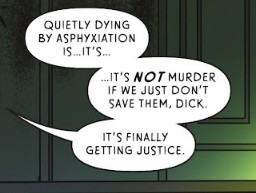
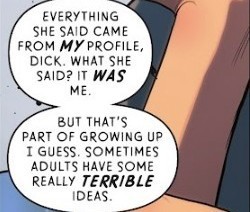
Not only that, but Tim has shown this belief through his thoughts and actions before. Twice.
The first time goes all the way back to Robin 1991 #5. During the fight against King Snake, Tim kicked him through a nearby window, fifty stories above the ground. As King Snake's life hung in the balance, Shiva appeared and commanded Tim to kill him.
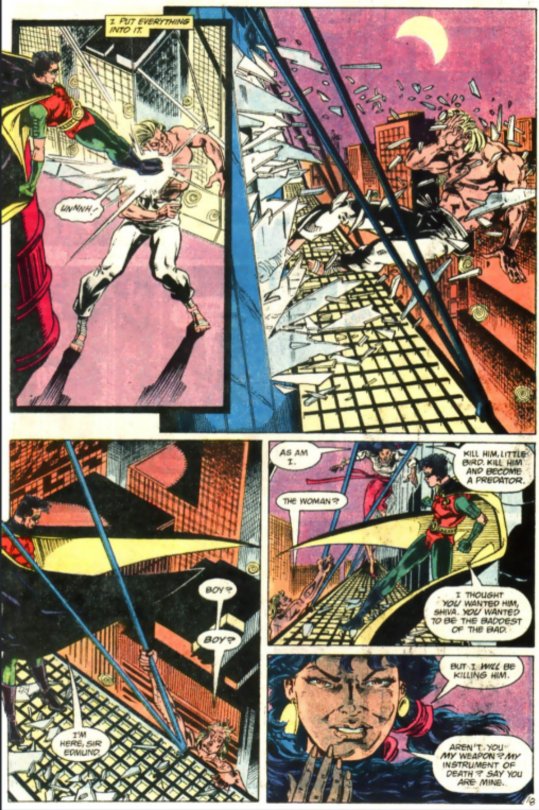

Tim refused. He walked away, leaving King Snake entirely at Shiva's mercy.
What gets me is that Tim made no move to save King Snake from falling. And he made no effort to stop Shiva from committing the murder, either. His only thought as he heard the man's scream was "Fifty stories is a long way to fall."
The second time was in Red Robin 2009 #26. Tim orchestrated a whole plan to manipulate Captain Boomerang into getting killed by Mr. Freeze. The whole time, Tim blamed Captain Boomerang for making all those bad choices, despite Tim being the one raising the chances of them being made. Tim believed he was innocent because he wasn't directly participating.
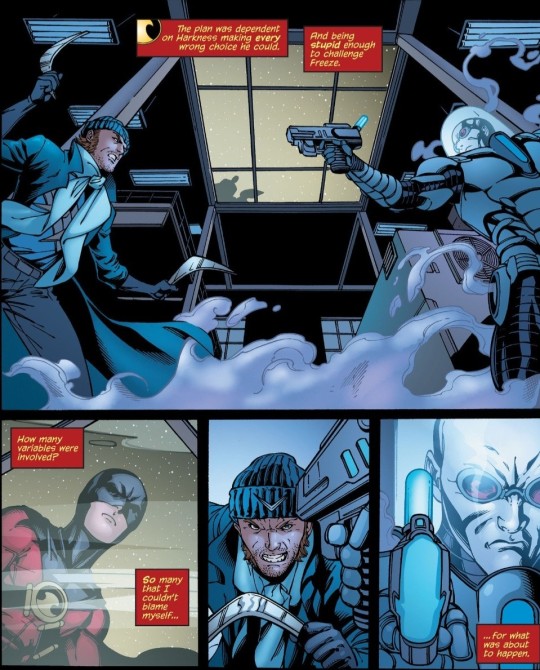
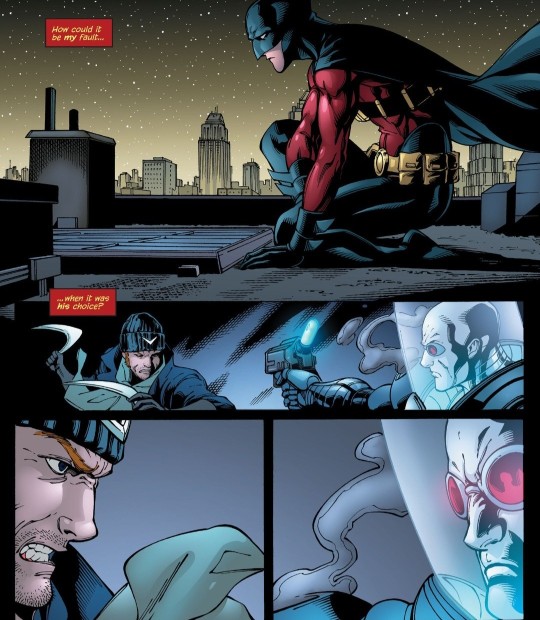
Tim then stopped that plan, but not for any noble reason. He decided that he couldn't let anyone else kill Captain Boomerang but himself.

Tim couldn't bring himself to do that, either. So he had to spare his father's killer in the end.
This seems pretty cut and dry so far, right? Tim believing that letting villains die is alright as long he doesn't do the deed himself? I'd think so too, if there weren't other moments contradicting this.
In Robin #35, Steph insisted on leaving an enemy who got buried under the snow to die. Tim chastised her for it.

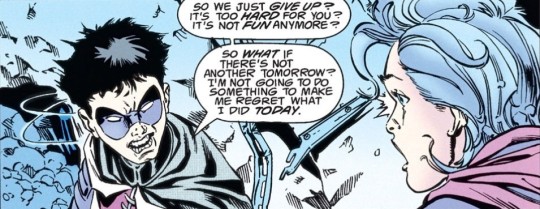
Neither of them were responsible for the snow, or for the enemy getting trapped in it. Plus, that guy tried to kill them with a chainsaw moments prior, so he's not exactly an innocent damsel in distress.
Maybe it was because this enemy wasn't a big enough fish to fry. We didn't really get confirmation that this guy has actually killed before, and he's around goon status at best.
But then in Robin #46, Tim chose to save another enemy who got himself into a deadly situation. That enemy was a murderer known as Young El. This time, Tim wasn't telling anyone else why they should save a murderer's life out loud. These were his private thoughts.
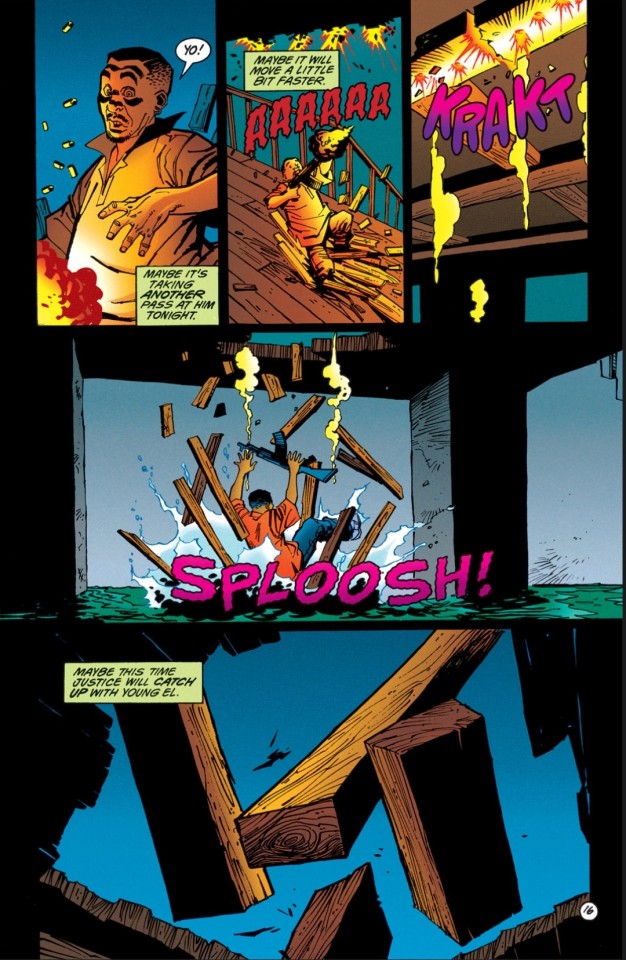
Notice how Tim's inner monologue sounded kind of on-the-fence. He contemplated justice finally catching up with Young El as the floorboards gave way, bringing a support beam down on him in the process.
However, Tim immediately switched gears to rescue Young El from under that beam before the water rose too high.

But Tim, as he told Young El the reasons he's saving him, asked himself "Do I even believe what I'm saying?" He could be asking this about two different things he said here. A) "Maybe it's not too late for you to learn something, Young El.", or B) "Death's easier for you when it's the other guy. Death's never been easy for me."
For Tim to doubt his belief in either of these statements is very interesting. He could be questioning if Young El is already too far gone for redemption, or he could be questioning if seeing someone die has never been easy for himself. For all we know, it could be both.
Unfortunately, Tim never got to see if his choice to save him would pay off. Tim wasn't strong enough to lift that beam, and Young El drowned.

There's a question on my mind as I read these pages. What makes this murderer's death different from when Tim let King Snake fall to his "death"? Sure, King Snake didn't actually die, but Tim didn't know that until later when the man came looking for revenge in Gotham.
Tim was once able to simply walk away from what he was certain would be a killer's demise. But then he's consumed by guilt over not being able to prevent a different killer's death down the line, to the point of hallucinating.

On top of that, what changed Tim's mind later? Red Robin #26 and Robins 2021 #3-6 still happened in the future. The only significant difference I can tell is that these two comics involved the killer's of Tim's parents, making it personal. But if the Imposter from Robins 2021 got his beliefs from his profile before his mother's killer got involved, then does that still hold up?
Maybe we should put a pin on it for now. There are other things Tim's done that brings the details of his no-kill rule into question.
Such as that one time Tim actually killed someone with his bare hands.
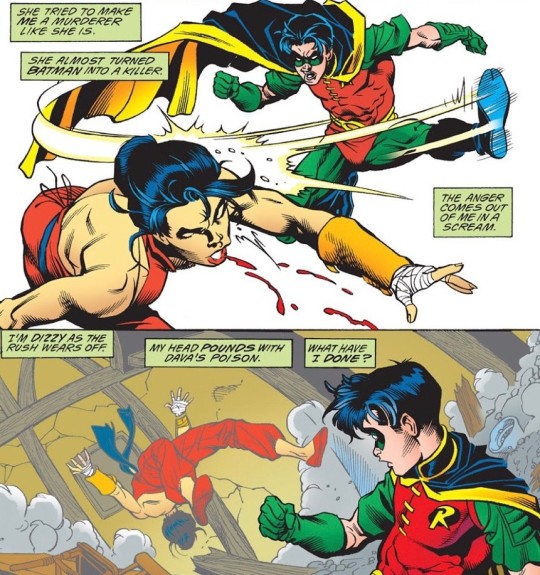
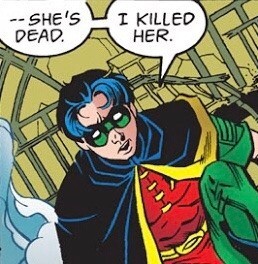
In Robin issues #51-52, Tim accidentally killed Lady Shiva while drugged on amarilla, a plant that enhances the user's speed beyond human limitations.
It may be argued if the amarilla altered Tim's mind enough to excuse him of fault or not. However, I want to focus on what happened after Shiva was revived. Here's another question to go with the first one:
Does Tim believe the kill still counts if the victim was revived afterwards?
From what I've gathered, yes and no. It's kind of complicated.
After Tim killed Shiva, he was understandably distressed about it, about how he can never take it back.

But after Shiva came back to life? Nothing. He didn't dwell on the fact he broke the vow to never kill. For something that devastating to happen in his life, it's odd that Tim didn't bring it up ever again, privately or otherwise. Especially considering what happened later in Robin #123, when Tim thought he killed Johnny Warlock.
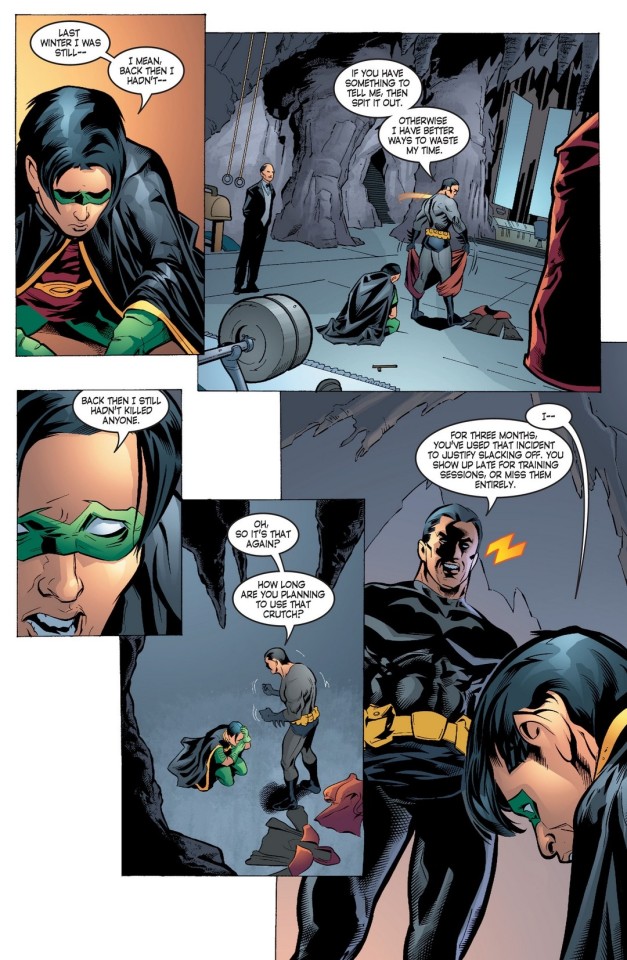
Tim was utterly inconsolable. He lost all faith in his abilities as Robin, and in himself as a whole. It also contributed to his decision to quit being Robin after his dad found out. In general, he seriously dwelled on that "kill" for a much longer time than he had after killing Shiva. The difference being that he knew Shiva was resuscitated immediately afterwards, while Tim didn't know Johnny survived until issue #141.
But there's the fact that Shiva really did die. Her heart and breathing both stopped. So are we to believe Tim moved on from that so easily because she's alive now? What happened to never getting that back?
Come to think of it, not long after Tim killed and revived Shiva, there was someone else who landed in that same boat. Dick.

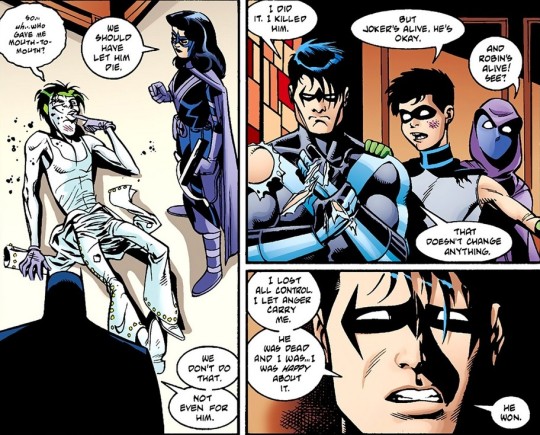
In Joker: The Last Laugh #6, Dick brutally attacked the Joker after believing he killed Tim. Dick ended up accidentally killing Joker instead, before the clown was resuscitated.
Here's the thing. While Tim was trying to comfort Dick, saying that it's ok because Joker's alive now, Dick didn't believe so. He was still distraught that he killed someone. The fact Joker came back to life afterwards didn't matter to him. To Dick, it still counted. So what does that say about Tim?
Before we move on, there's another person Tim knows who also died and came back from the grave. Jason.
Tim openly acknowledged Jason was killed before coming back, too. Multiple times. For example, when they met up in Red Hood and the Outlaws 2011 #8.
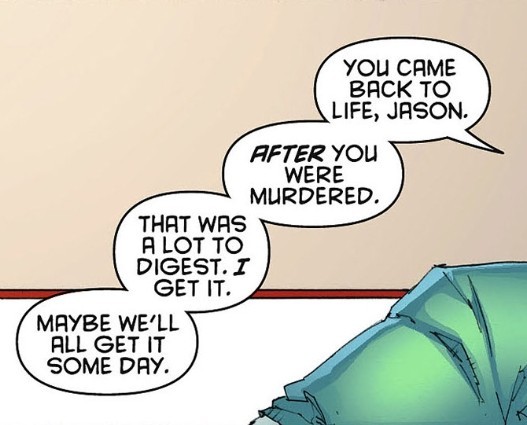
Tim hadn't shown any signs that he thinks Jason's murder doesn't count anywhere, except for maybe once.
In Knight Terrors: Robin #2, Tim and Jason had a heart-to-heart, and Tim said something strange.

"You survived."
Except Jason didn't survive. He died. To say Jason survived that night would've meant he never died to begin with. Him being alive now doesn't change that. Was this Tim telling a white lie to make Jason feel better? Or does Tim see being revived after death as "surviving"?
Ok, now we can move onto the next question. Or rather, bear with me as we go back to the first question. It's a broad topic with plenty more to talk about.
What does Tim count as breaking the no-kill rule?
We already asked how Tim feels about bringing villains back from the dead after killing them. And we asked how Tim feels about leaving a villain to die without getting directly involved. However, we still don't know how much involvement Tim needs to have in an enemy's death before he'll take responsibility for it.
We can confirm he won't mercy kill in Red Robin #21, even if it means giving someone a fate worse than death. No exceptions.
Tim also doesn't allow anyone he's actively teaming up with to kill, especially if he's the one in command. He's been amicable with known killers before (Huntress and Pru, for example), but only when they remain non-lethal while working alongside him.
Apart from that, though, it becomes less clear. However, I think this is a good place to expand on when Tim blew up a lot of League of Assassins bases in Red Robin #8.
I'm not going into whether or not those explosions actually killed anyone. I've seen evidence supporting both sides of this debate, so I'm just going to say it's up to interpretation. What I AM talking about is whether or not Tim would've felt responsible if they had killed someone.
Before overloading every generator in the LOA database, Tim gave a warning to the Wanderer. He told her that he couldn't be held responsible for what would happen to her if she didn't leave.
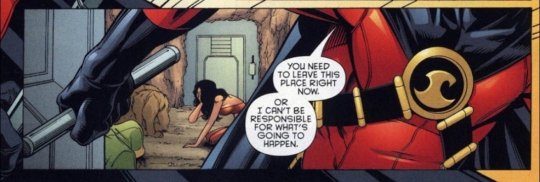
After initiating the explosions, Tim warned the White Ghost that they had fifteen seconds to leave before it was too late.
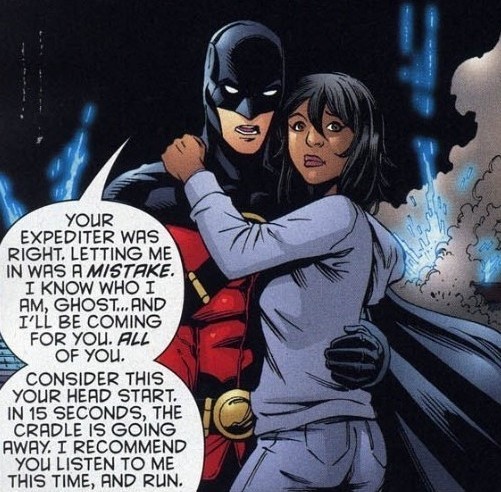
Fifteen seconds. That explanation on the mistake of letting him in might've taken roughly another fifteen to twenty seconds. Did the other bases even get a full minute head start? The way some of the people were already running away could imply they at least got a warning, but it's possible they might not have.
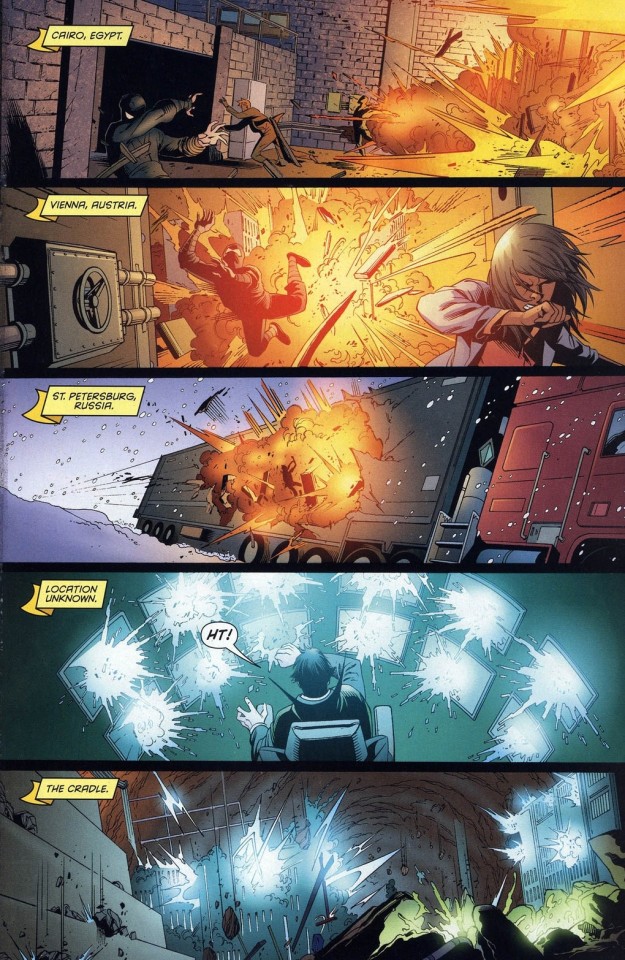
Even if everyone in every base received a warning, would that be enough for Tim to avoid holding himself accountable if they didn't make it out in time? Tim's the one who rigged the bases to explode, but I guess giving someone a warning means it's now their fault for not heeding it?
We can't be sure he even considered the possibility of those explosions killing anyone. Tim knew they were dangerous enough to bring the whole Cradle down, and the other ones we saw looked pretty powerful (except the ones in Ra's hideout). But Tim also called Ra's a murderer right after that happened, which would've been very hypocritical if Tim himself thought he committed murder.
So, my guess is either A) Tim relied on sheer luck for those explosions not causing any casualties and chose to believe they hadn't, or B) Tim didn't believe the deaths of anyone caught in them would be his fault.
Again, this isn't about whether or not blowing up the LOA bases killed anyone. It's about how willing Tim was to take that risk, and if he would've blamed himself for anyone getting killed from it.
Either way, it's canon that Tim had no guilt for the explosions he caused, or for anything he did before Red Robin #22. Just ask the Sword of Sin.
This is an exerpt I got from the Fandom DC Database on the Sword of Sin:
"The Sword of Sin can be ignited with the mind of the wielder, if the person is powerful enough. The sword has the ability to conjure in the mind its victims all of the sins for which they are guilty or have not atoned for."
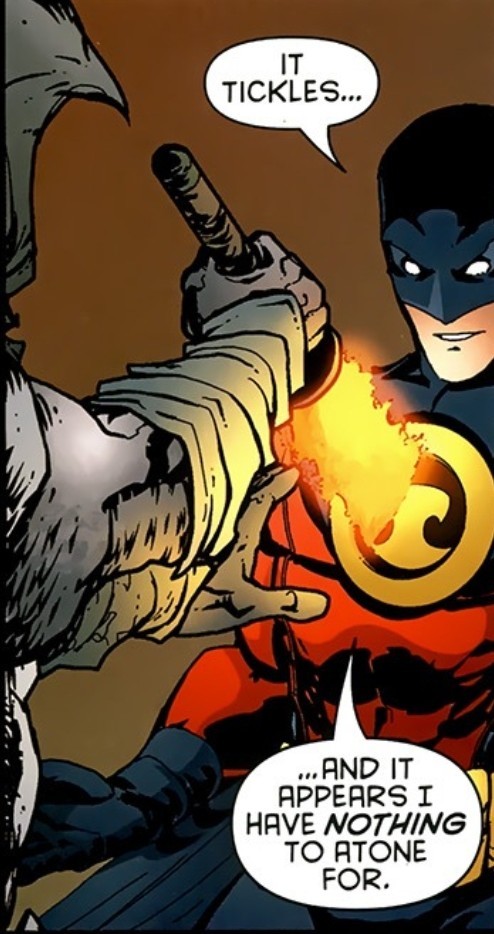
When Tim was stabbed with this sword, he was immune. The Sword of Sin decided he was innocent. Although, I have to ask how reliable this sword was in making that judgement. If the sword is judging others based on its own set principles, then something's not right here.
The Sword of Sin was also used on Dick, and he wasn't immune. It dug into Dicks subconscious and unearthed memories he'd long since repressed. Memories of himself watching a boy get beaten to near death, and then doing nothing. He just walked away.
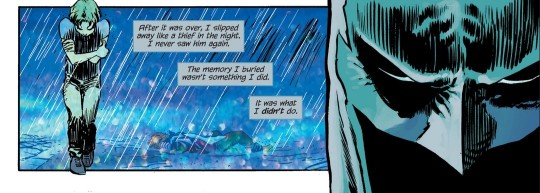
Now, tell me why the sword brought this to light, but not the time Tim left King Snake to die!
It wasn't an accident. Tim deliberately chose to leave instead of trying to save this man from the murderous Lady Shiva. Sure, Tim was no match for Shiva and he might've not been able to stop her, but the same could be said for an eight year old Dick not stopping a group of much older kids. Neither of them tried to stop the attackers.
Tim didn't atone for it, either. When King Snake returned in Batman #469, Bruce told King Snake that it wasn't Tim who left him to die. We know that's a lie, but Tim never corrected this. He let Shiva take all the blame.
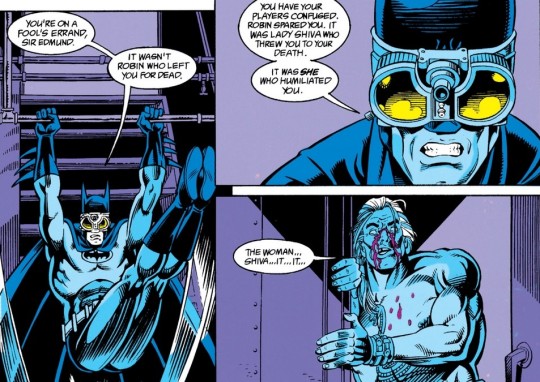
We have two instances of a boy choosing not to prevent someone from having a near death experience. One guilty, and one innocent.
Did the Sword of Sin think Tim was justified because King Snake was corrupt? That doesn't sound holy to me.
Was it because Tim didn't feel any guilt over it, while Dick did? Can the sword's judgement be thrown off by the victim not feeling any shred of guilt over their actions, even subconsciously?
That could make sense given what we know Tim did in the past: King Snake falling, the vandalism (explosions), and ALL the lying over the years (Tim reviving Shiva might count as atonement, so I'm not including that). If the sword based its judgement on God's will alone, then odds are high it would've picked up on one of these.
Even so, I'm not going to sit here and say this is definitely the case. I'm not familiar enough with how the sword effects other characters to make that call.
If this is indeed false, then did the DC universe's version of God decide to pardon Tim of his sins when he prayed earlier that same issue, despite him not believing he had any? I mean, who knows, right?
You can probably see why there's more questions than answers. The point is Tim didn't have any guilt for the things he did before Red Robin #22. Tim was canonically convinced he had nothing to atone for.
So then why did he say the opposite later in Knight Terrors: Robin #2?!
In the heart-to-heart between Tim and Jason, Tim tells him this:

"You have a lot to atone for...We all do..."
Tim knows that the words "we all" include him, right? By saying this, Tim admitted to also having things he needs to atone for, right?
Is this another white lie to make Jason feel better? Is it one of those slight changes the New 52 made to the canon? If not, then why did he change his mind? Did his no-kill rule change and make him feel guilty for some past actions? Is it not the no-kill rule, but something else?
What changed?!
Where does Tim draw the line?
I don't know. We've narrowed it down to a general area, but it's kinda hard to see a line when it's so blurred it could be a gradient.
Tim baffles me. He acts as a steady moral compass for others when he can't even seem to stay consistent with his own. You're free to call it poor writing (and honestly, fair), but I find his hypocrisy fascinating.
That's what it is, isn't it? Tim's a hypocrite who's completely oblivious to being one. And it's not like this was never mentioned in the comics before. Damian called him out on it!
In Batman & Robin 2011 #10, Damian confronted Tim about his near-murderous reaction when Fist Point killed Artemis (Teen Titans Vol 4 annual #1). Damian then accused Tim of constantly rejecting him because they have more in common than Tim's willing to admit.
It's debatable how accurate that accusation was, but Tim had a pretty volatile reaction to it.
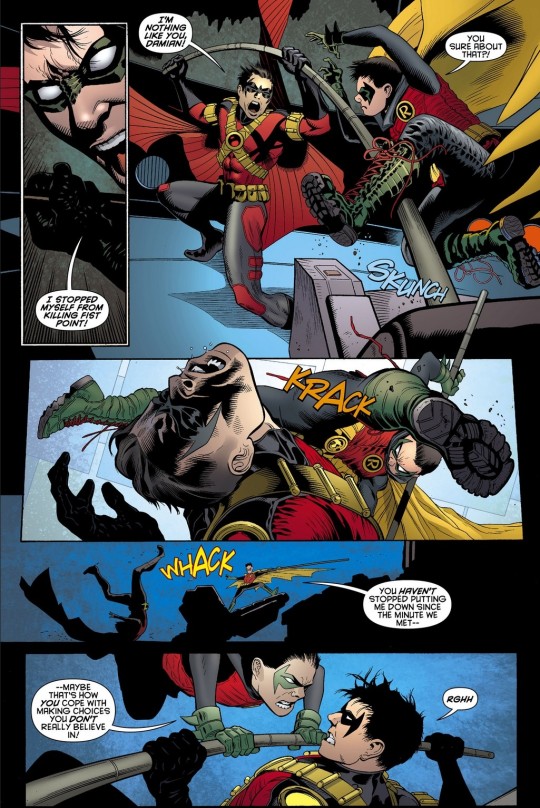

"I believe in every choice I make!"
Does he? I don't think someone who's so sure of what he believes in would contradict himself to this extent. Especially if he wasn't doing it on purpose.
He wouldn't vehemently push Bruce's no-kill rule onto others and berate them for bending that rule, only to go and bend that same rule himself when the Batclan isn't around. He also wouldn't exploit what he thinks are loopholes, decide later that those loopholes broke the no-kill rule, and then earnestly claim he never broke it.
Why is he like this?! He's had arguably the most normal childhood out of the whole Batclan before becoming Robin! What could've made him so fickle about this?!
Where does he draw the line? And how will he know when he's crossed it?
#batman#dc#robin#tim drake#red robin#theory#analysis#long post#tim drake is a menace#unhinged tim drake#To think all of this was written without mentioning Tim's corrupt future selves#or the numerous times he's actually contemplated or attempted murder#Believe me I would've loved to add 5-10 more screenshots of those moments alone#but I hit the 30 image limit :(#Anyway I want to study Tim in a lab#Feedback is welcome#I'm aware I hadn't read all the DC comics so I could've missed something
350 notes
·
View notes
Text

Now THIS is how youturbotastic
#I hope you guys know this was hell to screenshot correctly#turbotastic#wir#wreck it ralph#turbo wreck it ralph#shout out randomalistic if it weren’t for them I wouldn’t have known abt wreck it ralph#art#is this art?? ya probably#I’d add more but I don’t want my computer to implode
279 notes
·
View notes
Text





personal experiences. sharing things for the sake of sharing at this point
the game doesn't have a whole lot of words to translate but russian translation hits different somehow
#buckshot roulette#buckshot roulette fanart#buckshot roulette dealer#dealer buckshot roulette#the dealer#doodle post#doodle dump#every now and then i remember that posting rough nonsense on my artblog isn't a crime and maybe something i should do more often#i only have like two people i usually share these with and both of them are learning of the game solely through me lol#the grid is just a csp image material i found recently. leaving it in because i feel like it adds to it#edit: i uploaded the Wrong screenshot version goddammit#also: 'last dance' would probably br more accurate in place of 'final' if i wanted to be Direct but i forgot to change it
192 notes
·
View notes
Text

THIS WOMAN IS COOKING MY BRAIN
#send help#i want to gnaw on her#femshep#commander shepard#sunglasses are from mornings accessories and hair is by jasontodd#december shepard#my beloved#i want to huff her like paint#mass effect#shepard#i came back to add more tags to this because its 8am and i cannot stop thinking about her#shepard thirstposting#fuck me dude just LOOK AT HER#idk if i already posted this screenshot and i dont care look at her again lmao#i would let her choke me to death with her thighs#incoherent gnawing sounds
104 notes
·
View notes
Text

I'M ACTUALLY DOING IT
#had to take a screenshot of my other post because tumblr wouldn't let me add a video to the reblog 😭😭😭#forgettable-au#wip#I actually have more than this already done but I don't want to spoil anything hehe
242 notes
·
View notes
Text

"Will you come back from this?"
"Does it matter if I do?"
[screenshot redraw from the absolutely fabulous transformation cutscene]
#destiny the game#season of the witch#eris morn#ikora rey#ikoris#<- this drawing is intended to be read as gay yearning. thank you#destiny 2#fanart#screenshot redraw#i wanted to add a little bit more emotion to the scene bc 3d models can't capture the details of the human face so well#i hope i did it justice because this little 2 lines of dialogue wrecked my shit!!!!!!!!!!!!!!!!!!!!!!!!!!!!!!
280 notes
·
View notes
Text

august's favorite fits!! 🍊
#this was so fun to make i wanted to add more but also didnt wanna clutter too much#he slays#my favorite manwhore#ts4#the sims 4#simblr#ts4 simblr#ts4 screenshots#ts4 blog#my sims#ts4 edit#mobwhim#ttl#tte#sim: august
78 notes
·
View notes
Text


#I've made an extra masc v#no name and no story yet#I just want more masc v#masc v#male v#you might see him around and I hope to add some story to him#cyberpunk 2077#cyberpunk 2077 phantom liberty#cyberpunk 2077 photomode#cp2077#cp77#cp 77#cp2077 photomode#cp2077 screenshots#game photo
46 notes
·
View notes
Text





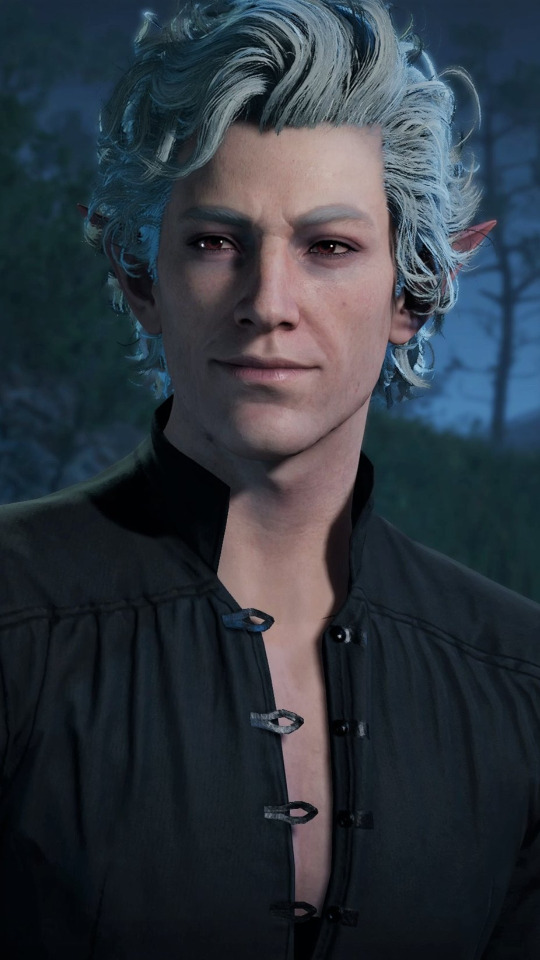
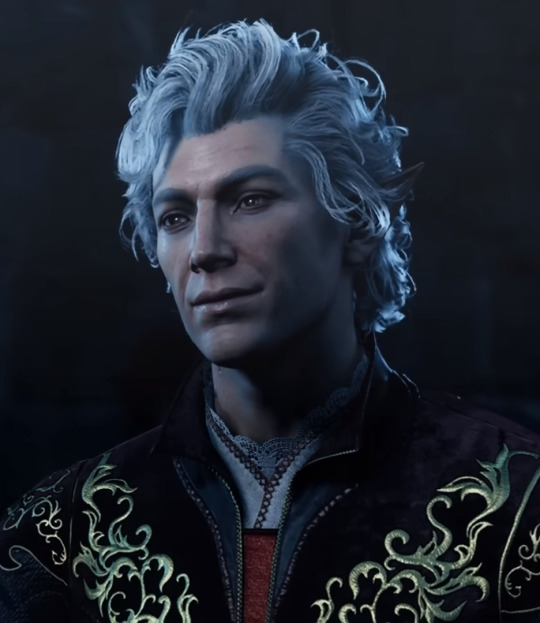



him
#baldur's gate 3#bg3#astarion#saw someone say “i haven't been this obsessed with anyone since i was 14”#and i agree#just... the hold he has on me#he's just a person who's been through a lot#and he might come out the other side#he might not#but he's him#this is edited btw.... i added more#I WANT TO ADD MORE BUT I'VE HIT THE LIMIT TO HOW MANY IMAGES I CAN ADD TO A POST FUCK TUMBLR#screenshot
133 notes
·
View notes
Text

✦ D I S C I P L E O F T H E H A N D
Alchemy for potions. Blacksmithing for repairs. Leatherworking and weaving for mending. She is not an artisan, but the basic skills she has picked up over the years have served her well. Self-sufficiency has always been at the forefront of her mind, and she is pleased that she can keep herself afloat when needed.
Besides, crafting is relaxing. A hobby or two here and there is good for her mind.
—level 90 compendium
#ffxiv#ff14#final fantasy 14#gpose#gposers#ffxiv gpose#lvl 90 compendium#myreia screenshots#aureia malathar#oc tag#doh#give me more glam plates so all of my doh don't have to be on the same plate SE you cowards!!!#so funny story: i didn't want to craft at all#and then i came back from a 6 month break and started doing a bit of doh on my alt#and i really liked it#so i stopped playing my alt and went back to aur and now she has full doh/dol LOL#the quests are so cute i really enjoyed how different they are from the combat ones#and i love the doh/dol tribal quests (the ones i've done haven't done all of them yet)#they're a nice change of pace#i just find it funny that i went from basically combat only - kill kill kill - to “give me a second i need to make this thing rq”#retirement arc in full swing#but nah it makes sense for aur to be self-sufficient#she's not an expert at anything doh-related but she knows enough to keep her stuff maintained#she has a whole cooking arc that rearranges her relationship with food and family after feeling for years like food is for fuel only#and she makes her own earrings#one of the reasons she has as many piercings in her ears#(not possible in screenshots since i don't have the skill or the knowledge to add them to her ear mod just pretend they're there!)#and a piercing in her navel is because she did them herself as a way to regain bodily autonomy after defecting from garlemald#she fixes her friends and her partner's gear too when needed#also please perceive nutkin chilling in the background i love that little munchkin so much you have no idea
25 notes
·
View notes
Text
HSR spoiler talk ahead
.
I think this is a popular theory, where we are in a timeloop dream in Penacony, and upon a re-watch im starting to think it's true.
Some moments that stand out to me are when we first arrive in Penacony and meet Acheron, where she seems to recognize us. We also have a series of images flash on screen that might be what we've experienced before. That being said, I don't think the Acheron we interact with throughout the story is anymore aware of a loop than we are, this moment felt like a slice out of time.
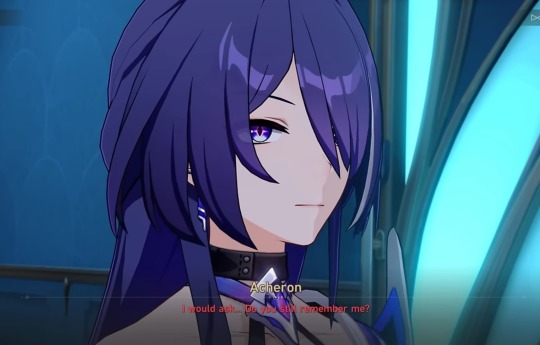
Another moment is when we're tracing Firefly's footsteps and in the tv room, she says she wants to try again. I wouldn't have given it much thought had Acheron not drawn more attention to it. She also seemed more attached to us than what a day would allow but thats my own view.


What really kinda sealed it for me was when we met Aventurine at the end. When we were walking down the hallway, he said it was a familiar hallway to a familiar room and says he remembers the little game we played. The way it's phrased makes it seem like he's just talking about our meeting at the beginning of the game when he gives us his room but he says "I finally remember". I think that memory he was referring to was that but now it seems so far away since he did indeed remember everything. To us, we met him a day ago. Maybe with his memories back, it's been much longer.
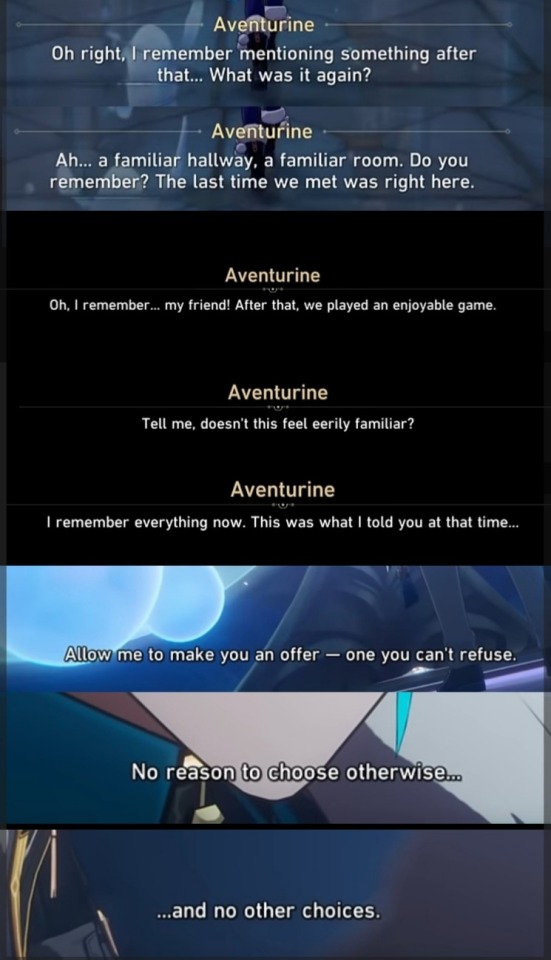
There are other things that I'm absolutely missing but these were three key moments for me. There's just some little stuff that seems to allude to reversing time, such as clockie and the clockwork powers. And there's definitely something going on with Misha, and I bet we've had a closer relationship with Robin at some point.
Whether it's the Watchkeeper's legacy or the family or how anything is possible in a dream or hell if there's another memokeeper around who's less benevolent and is messing with everyone's memories, I don't think this is our first run.
And a fun similarity: Acheron sometimes speaks with red text, something that happens in umineko no naku koro ni which happens to be a time loop of sorts, or rather a retelling of what story was actually told. When a certain character speaks in red text, it means that what she's saying is the truth.
I'm very curious to see what the red text means for Acheron. She says we will see the world in black and white, but sometimes red will appear when there's a choice being made.
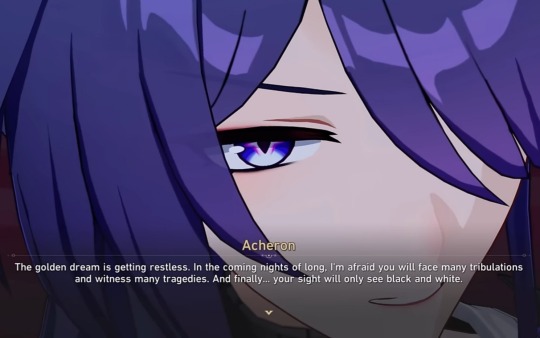
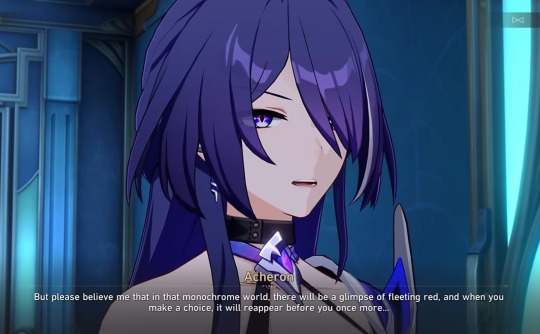
So maybe the red text she speaks is a choice being made - but there's no other choices. Like when you refuse for her to join you and Black Swan, she asks for you to repeat your answer until there is only one option left - also in red. This would also call back to what Aventurine told us when at the beginning of the game and what he repeated at the end:
Allow me to make you an offer - one you can't refuse. No reason to choose otherwise...

If it's a time loop, maybe the red text she speaks are things that will absolutely happen in every loop?
Anyway this isn't any actual theory crafting, I'm more just typing out my train of thought. I've seen other theories too - especially about Acheron and Firefly - and I'm really curious to see where this is gonna go
#i did NOT mean for this to get so long i only wanted to jot down some thoughts but then i had more 😣#then ofc i had to add screenshots. which i apologize for the bad quality; i added alt text if anyone cant make it out#honkai star rail#hsr spoilers#honkai star rail spoilers#hsr 2.0#acheron#hsr firefly#firefly#aventurine#nanjya.txt#anyway just take this ok
63 notes
·
View notes
Text



The Motion Picture Production Code (colloquially known as the Hays Code) circa 1956 vs Tumblr Fandom Police circa 2023
Spot the difference!
#proship#anti censorship#hays code#i wanted to add more examples of antis basically saying thought crimes are real#but tbh my folder of screenshots is soooo looonnggg and i have better things to do#feel free to add more examples in the reblogs tho :)#history is a straight line etc etc#also i know the hays code is from the 30s but this specific screenshot is of a printed copy of it from 1956
62 notes
·
View notes
Text
My queue is nearly full again (almost 1k posts!) so I've up'd the post rate and I also might step back for a few days as well!
#ooc#I've been queueing more screenshots rather than reblogging them directly#in hopes living through the broken mods of DT launch and what I expect to be a general lull in content output#because leveling#but you know#i feel silly announcing that i will....... maybe not be here#because why would anyone care !!!#but i know i am notifications p often and i don't want people to think they've *done* something#because no one did nothing i just have depression#if ur in the pits with me know that we'll get out of them together#happiness is fleeting but so is this feeling#you understand#editing my tags to add i hate that i called it content !!!!!#but you know what i mean orz
25 notes
·
View notes
Text
For any toontown tierlist fans out there. I made a tierlist for toons (mainly from ttcc, some rewritten is included) since I couldn't find any. I'll attach and image below of all the ones I included, but if anyone has any suggestions I'm all ears.
Link if you want it

#clemramble#actually im tagging it now. i lied about doing it later 3s ago#ttcc#toontown corporate clash#Some of these characters are cross-server#like surlee and lowden and flippy and you get the idea.#But if they were in clash I used the clash images since it was easier on me#theres also some characters missing bc theres no wiki link and with so many toons i didnt feel like going into game and personally-#screenshotting them. But I might add more later and do it#my goal is to eventually get every toon. unless theres over 2000 in which im limited by the website#Also requests aren't just ttcc exclusive. i'll add rewritten ones too if ppl want. idc im a toon fan i heart all toons#im just a ttcc focused acc/player so i feel it disingenuous to add a bunch of rewritten toons#anyways if this exists already i'll delete but all the ones i found were like. toon species or sounds and i wanted NPCS!!!
20 notes
·
View notes
Text
so im leaning towards ogjoseph having lived in fort pinta as a kid, then moved away for college and come back as an adult. he traded his pickup truck for a failed thoroughbred steeplechaser and became a ranger for a good few years. he hated the snow (just like neo alien joseph) and was annoyed that he got sent to the dinosaur valley outpost where hed eventually get alien possessed and made to kill everyone there. his thoroughbred spooked and ran off when he first encountered the alien but was recaptured by the team sent out to find the rangers who went missing
#his horse’s name is dragonborn because thats my horse’s name ingame#my pc is still busted as hell so idk if i’ll be able to get into the game for screenshots#but im busy as fuck anyway so… who knows#i hate having a job lol#normal guy noises#joseph#sso ocs#this feels very stream of conscious-y#and i want to get more detailed#but im really tired rn#so i’m gonna post this and hopefully add onto it tmr#im just really tiref rn skfjsjkk
23 notes
·
View notes